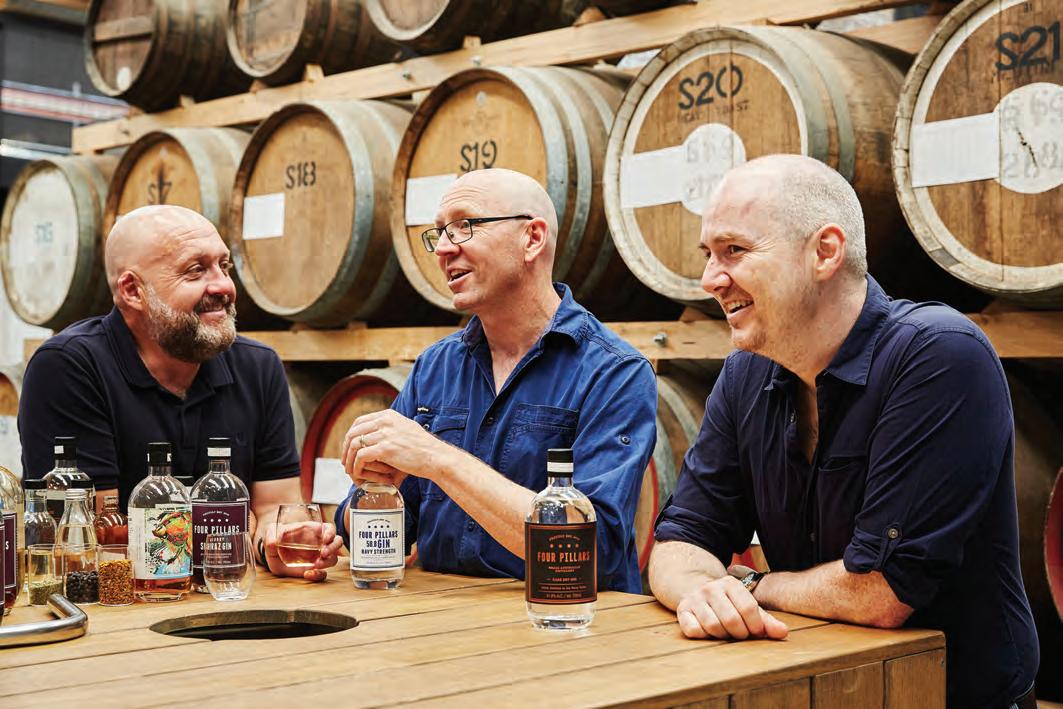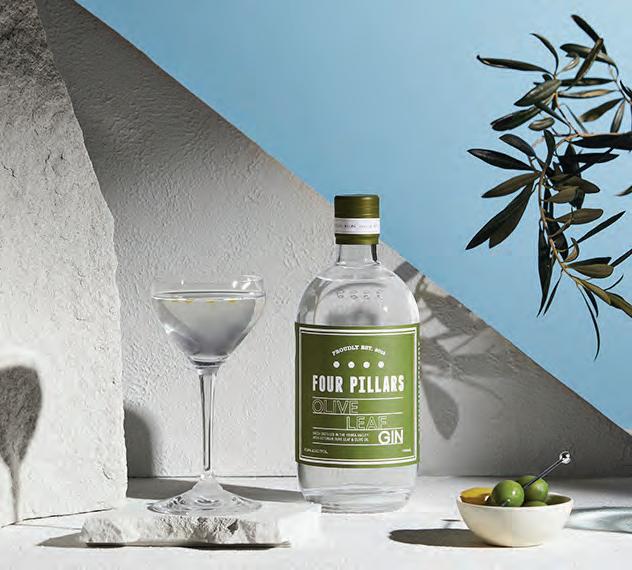
6 minute read
Gin, Hannah Sparks
Four Pillars co-founders Stuart Gregor, Cameron Mackenzie and Matt Jones
GIN IS BOOMING - but flavoured gin is exploding
Advertisement
AUSTRALIA’S THIRST FOR GIN IS SHOWING NO SIGNS OF SLOWING DOWN AND DISTILLERS ARE KEEPING UP WITH DEMAND BY CREATING ORIGINAL FLAVOURS FROM LOCAL INGREDIENTS. HOWEVER, THERE ARE NOW HUNDREDS OF GINS FOR CONSUMERS TO CHOOSE FROM AND NOT ALL BRANDS CAN SURVIVE IN A CROWDED MARKET, INDUSTRY LEADERS WARN.
The good news for retailers is that flavoured gin now represents $78 million in annual sales - and that number is growing. People are looking for new and interesting flavours, which Australia has an abundance of, says The West Winds Gin co-founder and chief executive officer, Paul White.
“Australia has ingredients that don’t exist anywhere else in the world: bush tomato, wattle seed, Davidson plum and sea parsley, [as examples], and there are no rules as long as the gin contains more juniper than anything else and more than 37.5 per cent alcohol,” Paul said. “So you can make it taste however you like.”
Australian Distillers Association president and Four Pillars gin co-founder, Stuart Gregor agrees and says the gin boom is more than a fad.
“Flavoured gin is like a grown-up version of where vodka went twenty years ago,” Stuart said. “Vodka also went through a flavour explosion, but they were all fake. There was vanilla vodka and pepper vodka, but all the distillers were doing was taking vodka and throwing in syrup. Whereas gin distillers start from the bottom up and look at what can be thrown into the botanical basket or pot to make the gin authentically different rather than manufactured different.”
Four Pillars began in 2013 and has often been ahead of the gin crowd. The YarraValley based distillery released its Bloody Shiraz Gin - made with local shiraz grapes - in 2015, well ahead of the pink gin craze.

Left: Hendrick’s Midsummer Solstice Right: Bombay Bramble

Now it’s broken ranks with its savoury Olive Leaf Gin, which was five years in the making and combines olive oil and olive leaf tea from Victoria with Mediterranean flavours - perfect for sipping or in a martini.
Likewise, The West Winds decided from the outset in 2010 that it would never copy other distilleries, and was the first to champion native botanicals such as bush tomato and make a salty gin, The Broadside. Interestingly, the Margaret River-based distillery won’t continue to produce a gin unless the first batch wins a gold medal and spends months experimenting with flavours. Its first gin, The Cutlass was released after 45 distillations while its newer gins, Pinque - made with Western Australia cabernet - and Christmas Gin - made with WA Christmas tree seed - took distiller Anthony Reynolds three months and nine months, respectively to complete.
Paul is concerned that distillers who jumped on the gin boom, later on, did so because they think it’s an easy business.
“If you want to do it and do it well, it takes a lot of effort to make a really good gin. There are some outstanding distilleries in Australia, but there aren’t many who have the experience to put together something with the right mouthfeel and flavours that are well-balanced and linger,” Paul said.
Chris O’Brien is the general manager of Liquor Barons bottle shops in WA and shares similar concerns. He said many of the new gins are “opportunistic marketing propositions” and a few of the newer gin distilleries exist “because their ultimate goal is to make whisky, and gin is a trend they’ve been able to jump onto to provide cash flow while their whisky is maturing.”
Retailers should question those brands’ commitment to the category, Chris says.
“We are starting to see what we saw in craft beer a couple of years ago - when consumers came to the end of their exploration phase and started to choose their favourites or go back to their favourites,” Chris said. “At that point, we would expect to see several of the new distilleries that were unable to connect to the consumer - either through brand or quality - disappear, because they’re not financially viable.”
Moreover, traditional gins such as Bombay, Hendrick’s, Gordon’s and Tanqueray remain as Australia’s best selling gin brands. Even still, the category leaders can’t deny the opportunity to grow with flavoured gin and have released their own variations.
Hendrick’s Midsummer Solstice - infused with rose and cucumber - launched in Australia in October 2019 and is supported by ‘the eye for the unusual’ campaign, which represents William Grant and Sons’ biggest investment in a single brand campaign in Australia. Midsummer Solstice will be followed by Hendrick’s Lunar Gin - a spicy expression that launched in the United Kingdom - in 2021.
Bombay Sapphire’s Bramble Gin - made with blackberries and raspberries - followed suit in July, and aimed to push flavour and colour boundaries by using real fruit that gives the gin a distinct crimson colour.
These international gin brands have a lot of history and trust with consumers, however, the Aussie brands are presenting a challenge and plan to flood the market in the next five years. Already, there is more Australian gin than imported gin on the market and that trend is predicted to last until 2024.
Adam Jenkins takes care of spirits for Dan Murphy’s as the merchandise manager at Endeavour Drinks and says consumers are “not only favouring Australian-made
Clockwise: Never Never co-founder Sean Baxter, Never Never Triple Juniper Gin and Four Pillars Olive Leaf Gin

gins but choosing gins that are produced as locally as possible.”
“For instance, customers in New South Wales are loving Archie Rose gin - which is made in Sydney - while customers in Victoria may favour something from Four Pillars,” Adam said.
Never Never Distilling Co. in McLaren Vale only released its first gin in August 2017, but is straddling the line between the new world and classic gins. Co-founder and brand manager Sean Baxter - former bartender and ambassador for Diageo’s Tanqueray and Gordon’s gins - said he never wanted Never Never to simply “fill a gap”. Instead, he and the other co-founders, George Georgiadis and Tim Boast have carved out a niche with Triple Juniper Gin (the juniper is steeped, pot-distilled and then vapour infused).
“I wanted to create an eternal style that could ride the ups and downs of trends. Juniper-forward styles have been around for hundreds of years and it just so happened there wasn’t a huge volume of those in Australia,” Sean said.
Like Four Pillars, Never Never also recently released a savoury gin under its experimental Dark Series. In line with trends, Med Gin is a nod to local.
“We wanted to create an expression close to home and the McLaren Vale is often described as Mediterranean in style, with the coast and fertile growing planes closely connected,” Sean said. “It’s made with locally-grown Mediterranean ingredients including oranges, almonds, olives, thyme and bay leaves.”
Right now, the explosion of flavoured gins allows retailers to personalise and have fun with their range. The challenge, however, is balancing the “cool, new local brands” with the “long-term established brands” that will always sell, Chris said.















